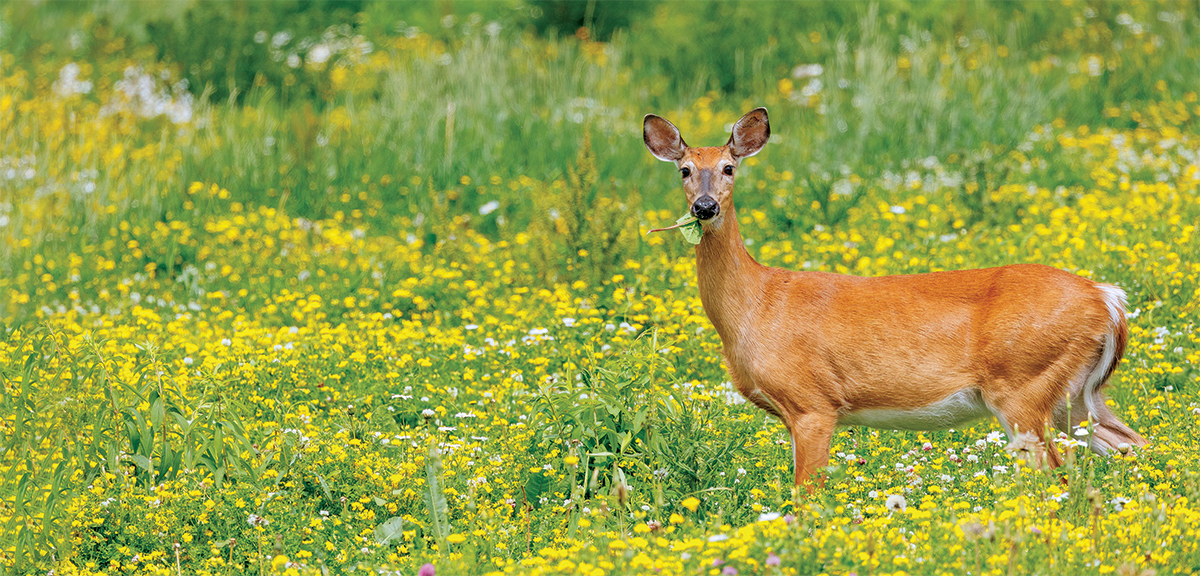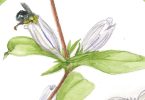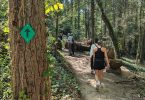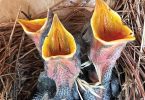
By Paula Musto
Few wild animals in North Carolina are as commonly seen as the white-tailed deer. Whether a mature buck with a towering set of antlers or a graceful doe with a speckled fawn or two in tow, these animals often represent a spiritual connection to nature.
For wildlife biologists who study the species, one of the most notable things about the animals is their ability to survive, and even thrive, in diverse areas with varying degrees of human influence. “White-tailed deer adapt well to a lot of different landscapes,” says Mikiah Carver, a wildlife biologist at North Carolina State University who is part of a three-year project in collaboration with the NC Wildlife Resources Commission studying the effects of urban ecology on the species. “We want to learn more about their movement, characteristics, behaviors and how they select resources (food and shelter).”
To date, the study has tracked more than 200 deer in the Raleigh-Durham-Chapel Hill area. Bucks (males), does (females) and fawns (babies) are tagged and collared to collect data for conservation and wildlife programs.
North Carolina has a population of white-tailed deer estimated at approximately one million animals. This represents a successful recovery from the early 1900s when the species declined by more than 90 percent due to over-hunting. Today, the animals are considered a prime example of successful wildlife management with limited hunting seasons that allow for healthy, sustainable herds throughout the state.
Yet, ever-expanding urbanization has altered the natural habitats these animals call home. At the same time, climate change is impacting wildlife in ways that scientists are just beginning to understand. “If we hope to maintain healthy wildlife populations in urbanized areas,” Carver says, “we must plan and build our cities in a way that is sustainable.”
For decades, conservationists have lobbied for wildlife passages and fencing that offer safe crossings across highways for deer and other wildlife in search of food, mates and shelter. Each year more than 1.5 million deer-vehicle collisions kill more than 200 humans and cause $1 billion in vehicle damage. The deer study can help state officials better understand the animals’ movement and could ultimately support strategies for safe passage that benefit both the deer and people.
Appalachian Wildlife Refuge (AWR) executive director Savannah Trantham knows all too well the damage to wildlife as a result of vehicle collisions. Each year the Candler-based nonprofit takes in close to 2,000 animals. “The majority of the fawns are orphaned due to their mothers being killed by automobiles,” Trantham says.
The most important thing automobile drivers can do is to pay extra close attention when on the road at dawn and dusk when wildlife is most active, Trantham advises. Use high beams at night, especially adjacent to wooded areas if there is no oncoming traffic, and if you spot one deer, scan the sides of the road as there’s a good chance other deer are nearby.
Female deer generally live in matriarchal groups. But during the fawning season (late spring or early summer) the does go off on their own to deliver babies and carefully hide them in the underbrush while they forage for food. The fawns’ spotted coats help them blend into their surroundings, providing protective camouflage. The mother will return several times a day to nurse, but avoids staying too long to prevent attracting predators.
Since the mother is frequently away, it is not uncommon for well-meaning people to stumble upon a fawn, lying motionless in a grassy area, and think they are abandoned. Almost always, they are not and should be left alone.
“Deer are well-loved animals,” says Nancy Vergara, an Asheville area licensed wildlife rehabilitator, who has worked with injured and/or orphaned fawns. “People relate out of the goodness of their heart and want to help, but mom has left them in a safe place and will return to feed them. Just because you don’t see the mom doesn’t mean they are not around.”
Vergara, the AWR volunteer program coordinator, advises calling the organization’s hotline at 828.633.6364, or the NC Wildlife Resources Commission helpline at 866.318.2401, if you believe the animal is in distress. There are ways to tell if a fawn is truly an orphan. Females continually lick and clean their babies so if the animal is not dirty, it most likely does not need help. An animal that is bleeding and crying incessantly may truly need assistance and, in that case, a trained wildlife rehabilitator can help.
Throughout history, deer have played a significant role in mythology and literature, often connecting us to the supernatural. They symbolize grace, elegance, gentleness and innocence. In NC, we are fortunate to have these magnificent wild creatures as neighbors.
Paula Musto is a writer and volunteer for Appalachian Wildlife Refuge. To learn more, visit AppalachianWild.com. For more information on white-tailed deer, visit the state’s wildlife commission at NCWildlife.gov.






